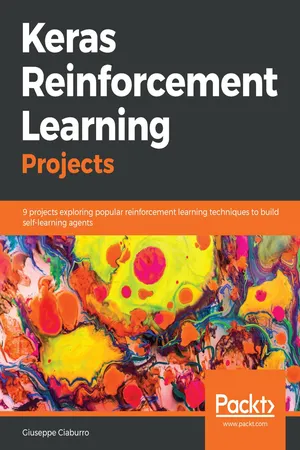
Keras Reinforcement Learning Projects
9 projects exploring popular reinforcement learning techniques to build self-learning agents
Giuseppe Ciaburro
- 288 pagine
- English
- ePUB (disponibile sull'app)
- Disponibile su iOS e Android
Keras Reinforcement Learning Projects
9 projects exploring popular reinforcement learning techniques to build self-learning agents
Giuseppe Ciaburro
Informazioni sul libro
A practical guide to mastering reinforcement learning algorithms using Keras
Key Features
- Build projects across robotics, gaming, and finance fields, putting reinforcement learning (RL) into action
- Get to grips with Keras and practice on real-world unstructured datasets
- Uncover advanced deep learning algorithms such as Monte Carlo, Markov Decision, and Q-learning
Book Description
Reinforcement learning has evolved a lot in the last couple of years and proven to be a successful technique in building smart and intelligent AI networks. Keras Reinforcement Learning Projects installs human-level performance into your applications using algorithms and techniques of reinforcement learning, coupled with Keras, a faster experimental library.
The book begins with getting you up and running with the concepts of reinforcement learning using Keras. You'll learn how to simulate a random walk using Markov chains and select the best portfolio using dynamic programming (DP) and Python. You'll also explore projects such as forecasting stock prices using Monte Carlo methods, delivering vehicle routing application using Temporal Distance (TD) learning algorithms, and balancing a Rotating Mechanical System using Markov decision processes.
Once you've understood the basics, you'll move on to Modeling of a Segway, running a robot control system using deep reinforcement learning, and building a handwritten digit recognition model in Python using an image dataset. Finally, you'll excel in playing the board game Go with the help of Q-Learning and reinforcement learning algorithms.
By the end of this book, you'll not only have developed hands-on training on concepts, algorithms, and techniques of reinforcement learning but also be all set to explore the world of AI.
What you will learn
- Practice the Markov decision process in prediction and betting evaluations
- Implement Monte Carlo methods to forecast environment behaviors
- Explore TD learning algorithms to manage warehouse operations
- Construct a Deep Q-Network using Python and Keras to control robot movements
- Apply reinforcement concepts to build a handwritten digit recognition model using an image dataset
- Address a game theory problem using Q-Learning and OpenAI Gym
Who this book is for
Keras Reinforcement Learning Projects is for you if you are data scientist, machine learning developer, or AI engineer who wants to understand the fundamentals of reinforcement learning by developing practical projects. Sound knowledge of machine learning and basic familiarity with Keras is useful to get the most out of this book
Domande frequenti
Informazioni
Simulating Random Walks
- Random walk
- Random walk simulation
- Basic probability concepts
- Markov chain
- Forecasting using a Markov chain
- Markov chain text generator
Random walks
One-dimensional random walk


Simulating 1D random walk
Indice dei contenuti
- Title Page
- Copyright and Credits
- Packt Upsell
- Contributors
- Preface
- Overview of Keras Reinforcement Learning
- Simulating Random Walks
- Optimal Portfolio Selection
- Forecasting Stock Market Prices
- Delivery Vehicle Routing Application
- Continuous Balancing of a Rotating Mechanical System
- Dynamic Modeling of a Segway as an Inverted Pendulum System
- Robot Control System Using Deep Reinforcement Learning
- Handwritten Digit Recognizer
- Playing the Board Game Go
- What's Next?
- Other Books You May Enjoy